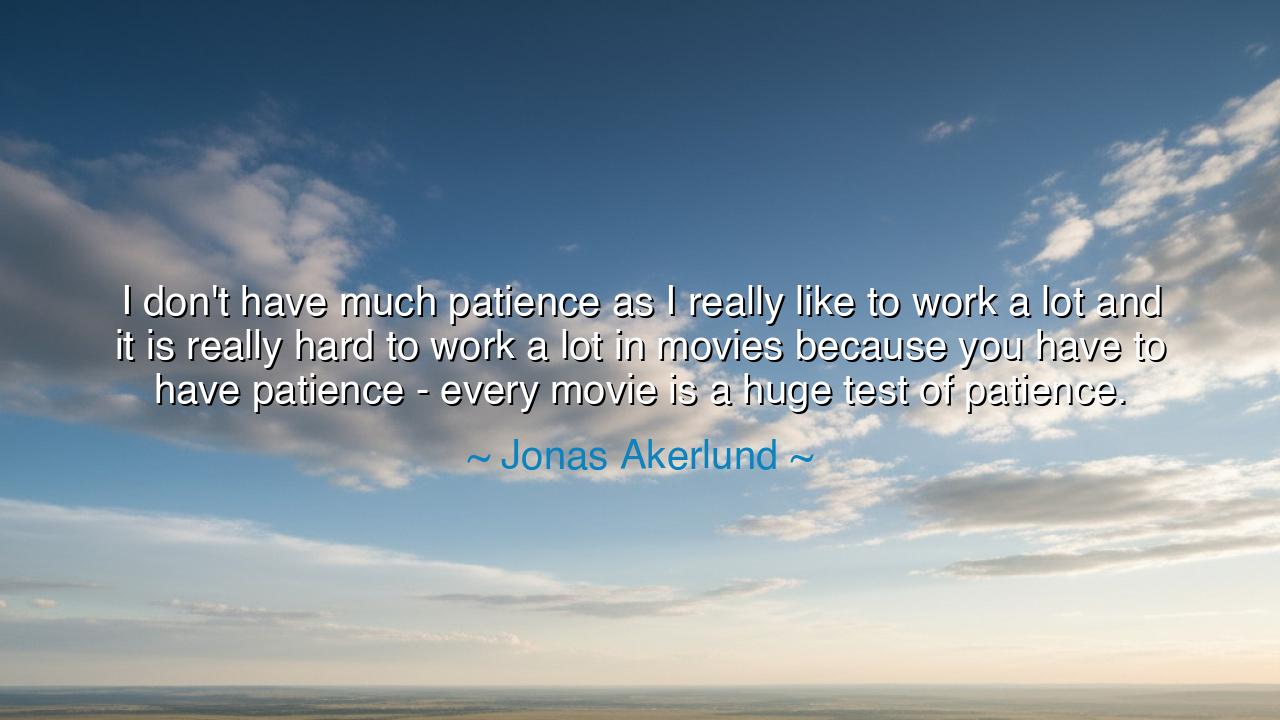
I don't have much patience as I really like to work a lot and it
I don't have much patience as I really like to work a lot and it is really hard to work a lot in movies because you have to have patience - every movie is a huge test of patience.






Hear the words of Jonas Akerlund, the artist of vision and restless energy, who confessed: “I don’t have much patience as I really like to work a lot and it is really hard to work a lot in movies because you have to have patience—every movie is a huge test of patience.” Though spoken from the world of cinema, these words reach beyond the stage and screen. They speak to the eternal struggle between passion and time, between the burning desire to create endlessly and the slow rhythms demanded by great endeavors.
For Akerlund reveals the paradox of the movies: they are born of labor, yet they move with the pace of mountains. Scenes must be set, lights arranged, scripts rehearsed, errors corrected again and again. Even the smallest detail demands hours of waiting. For one who longs to work without pause, to pour his energy ceaselessly into creation, such waiting feels like chains. Yet these chains are not meant to restrain, but to refine. Thus, the art of cinema becomes a crucible where patience is tested and strengthened.
The ancients, too, knew this trial. Consider the builders of the pyramids, who yearned to see their vision rise quickly into the heavens. Yet each stone required immense effort, years of toil, generations of waiting before the final form touched the sky. Or recall Michelangelo, laboring over the Sistine Chapel. His hand burned with the fire of genius, yet the work demanded endless days of scaffolding, grinding pigments, painting inch by inch, ceiling vast as eternity. His greatness was not only in talent, but in the endurance of patience.
Akerlund’s words remind us that to undertake great works is to surrender to time’s slow chisel. One cannot rush the symphony, the cathedral, the movie. Each requires a rhythm larger than our own heartbeat. To resist this rhythm is to bring frustration; to embrace it is to transform restlessness into discipline. The impatient spirit, though eager, may falter; but the patient spirit, though weary, will endure until the vision is complete.
Yet his honesty also unveils a truth: not all are naturally gifted with patience. Many burn with restless energy, craving ceaseless labor, endless creation. Such souls must learn the hardest lesson—that waiting itself is part of the work. For in the stillness between scenes, in the pauses of preparation, the mind gathers clarity, the vision matures, and the craft is sharpened. What seems like delay is often hidden growth.
History tells us this clearly. The voyages of Columbus required not only the courage to set sail, but also the endless endurance of calm seas, storms, and months without land in sight. Had he lacked patience, he would have turned back, and history’s course would have changed. So it is in every human endeavor: the dream demands energy, but the journey demands patience. Only where both exist together does greatness come forth.
The lesson for us is this: do not despise the waiting. If your heart longs to work ceaselessly, learn to see the pauses not as chains, but as part of the sacred rhythm of creation. Use the stillness to prepare, to think, to refine, so that when action comes, it is true and powerful. Remember always: every great undertaking, whether art, invention, or life itself, is a vast test of patience.
So let Akerlund’s words echo as both warning and encouragement: “Every movie is a huge test of patience.” And so, too, is every dream worth chasing. Burn with passion, yes—but temper it with patience, and you will see your vision not only begun, but brought to its fullest glory. For in the union of energy and endurance lies the true art of creation.






AAdministratorAdministrator
Welcome, honored guests. Please leave a comment, we will respond soon